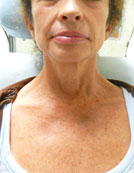It’s the middle of the summer in sunny Southern California and many of us are outside. Whether hiking, swimming, enjoying the beach or exercising outside, it is very important to monitor your exposure to sun damage. Overexposure to ultraviolet (UV) light is once of the leading causes of premature aging and cause wreck havoc on your skin, including sunburns, wrinkles and age spots.
Additionally, sun damage is the No. 1 contribution to skin cancer. In men, it’s also the leading form of cancer. Sun damage and other signs of aging are 90 percent to blame for signs of aging, according to the Environmental Protection Agency.
GETTING SUN DAMAGE SAVVY
While women are much more in tune with a skin care regimen, including daily sunscreen application, men are not. In fact, only 51 percent of men applied sunscreen last year, according to the Skin Cancer Foundation. Not surprisingly, double the number men died of melanoma last year than women.
Exposure to UV light causes sunburn, medically known as erythema. The time it takes for you to get a sunburn is dependent on your skin tone, if you applied sunscreen and an array of other protective factors, such as wearing a hat, sunglasses, protective clothing. Your skin exposed to UV light appears red because your skin cells are damaged. You body’s natural reaction is to send extra blood to these areas to repair the damage.
Additionally, exposure to UV light causes photoaging. While many skin changes are contributed to simply aging, UV light also causes loss of skin elasticity, wrinkles and age spots and may lead to skin cancer. Excessive, chronic exposure causes your skin to become thick and resemble a leather-like appearance with wrinkles.
FACT VERSUS FICTION ON SUN DAMAGE
Sun exposure provides vitamin D: TRUE
Three sources provide bone-, heart- and mood-boosting vitamin D. This includes supplements, certain foods and the sun. While sunblock prevents some of your skin’s vitamin D synthesis, you still get a spike in vitamin D levels after sun exposure, according to a recent study from King’s College London.
Acne clears up from tanning: FALSE
Sun exposure does dry out your skin but it doesn’t help acne. To the contrary, tannin can actually make your acne worse. Suntans cause your skin to become inflamed, triggering acne flare-ups and increasing production of acne-causing oils. Additionally, tanning can lead to post-inflammatory hyperpigmentation (PIH). This is when your past pimple and blemish scars darken, causing skin to become more uneven. PIH either requires aggressive topical treatments and laser skin resurfacing treatments to reverse.
Certain foods can help prevent sun damage: TRUE
Eating a healthy diet full of fruits and vegetables assists your skin to look younger, longer. Food rich in antioxidants help protect your skin cells from DNA damage caused by the sun. Antioxidant-rich foods to help prevent sun damage include artichokes, beans, prunes, pecans, plums, blackberries, blueberries, strawberries and drinking green tea.
Read Fact & Fiction on Sun Damage, Part 2 for more on ways to prevent sun damage.

